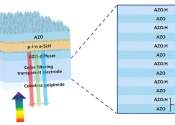The visible spectrum is the portion of the electromagnetic spectrum that is visible to (can be detected by) the human eye. Electromagnetic radiation in this range of wavelengths is called visible light or simply light. A typical human eye will respond to wavelengths from about 380 to 750 nm. In terms of frequency, this corresponds to a band in the vicinity of 790–400 terahertz. A light-adapted eye generally has its maximum sensitivity at around 555 nm (540 THz), in the green region of the optical spectrum (see: luminosity function). The spectrum does not, however, contain all the colors that the human eyes and brain can distinguish. Unsaturated colors such as pink, and purple colors such as magenta are absent, for example, because they can only be made by a mix of multiple wavelengths.
Visible wavelengths also pass through the "optical window," the region of the electromagnetic spectrum that passes largely unattenuated through the Earth's atmosphere. (Blue light scatters more than red light, which is why the sky appears blue.) The human eye's response is defined by subjective testing (see CIE), but atmospheric windows are defined by physical measurement.
The "visible window" is so called because it overlaps the human visible response spectrum. The near infrared (NIR) windows lie just out of human response window, and the Medium Wavelength IR (MWIR) and Long Wavelength or Far Infrared (LWIR or FIR) are far beyond the human response region.
Many species can see wavelengths that fall outside the "visible spectrum". Bees and many other insects can see light in the ultraviolet, which helps them find nectar in flowers. Plant species that depend on insect pollination may owe reproductive success to their appearance in ultraviolet light, rather than how colorful they appear to us. Birds too can see into the ultraviolet (300-400 nm), and some have sex-dependent markings on their plumage, which are only visible in the ultraviolet range.









